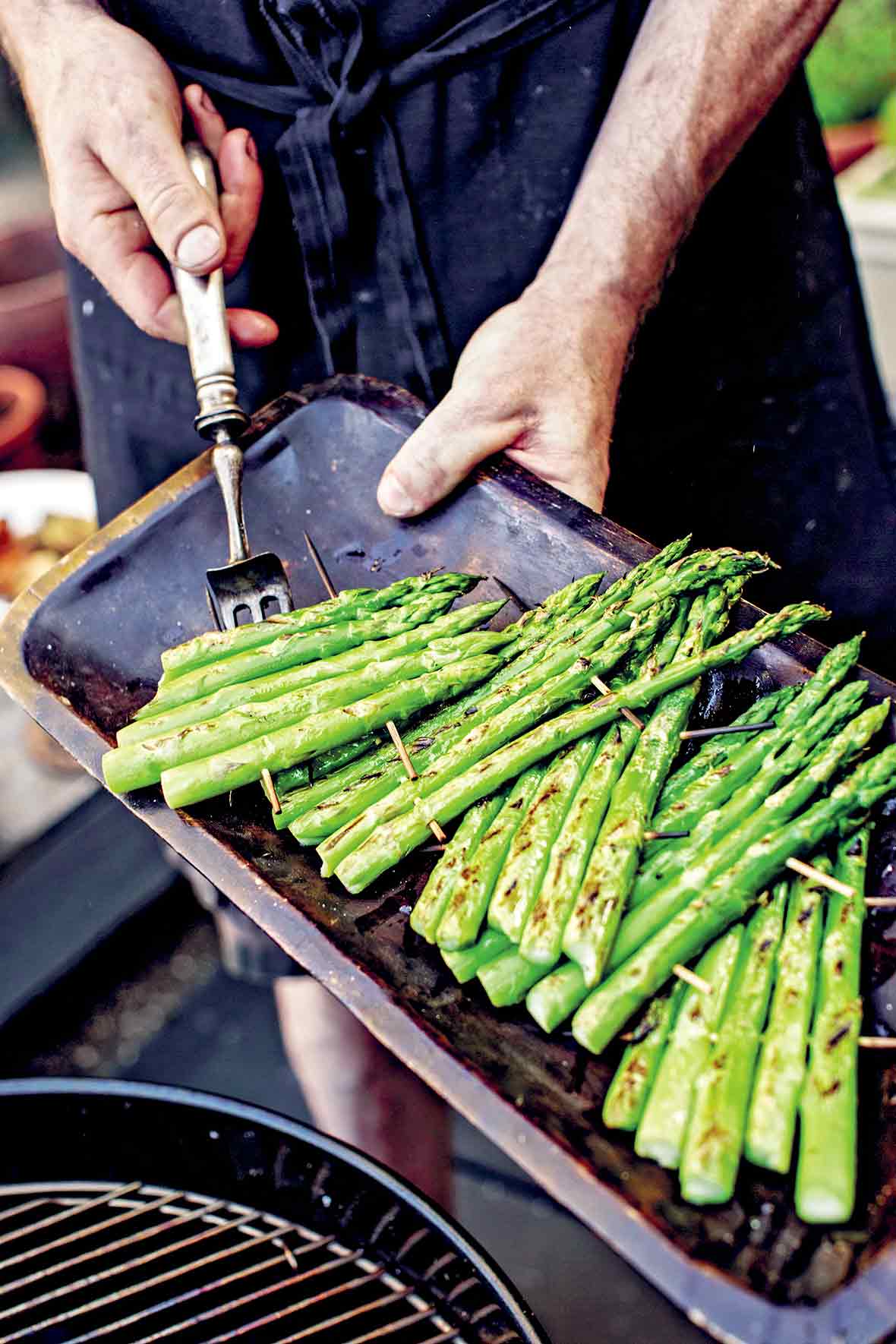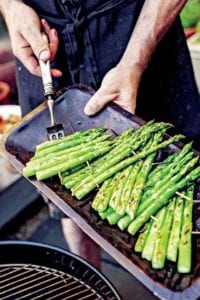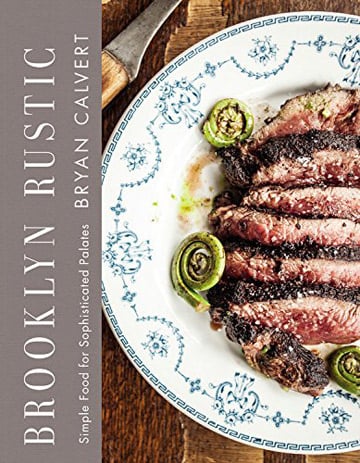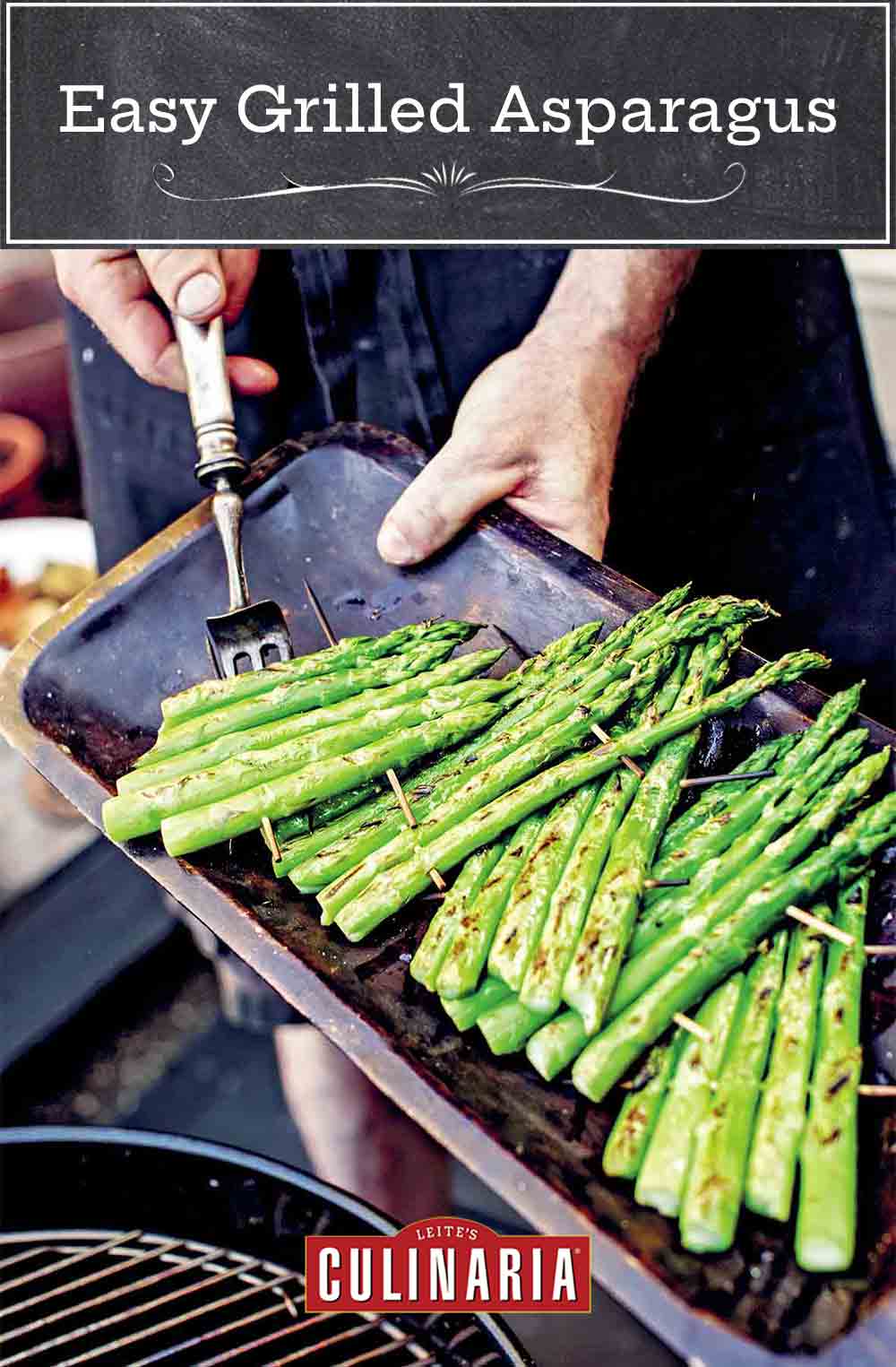
Here’s how to grill asparagus without some spears ending up charred into oblivion and others ending up crunchy and still others slipping through the grill rack (and you cursing up a storm). This easy approach relies on a reliable and simple technique of skewering several spears together into a raft of sorts, which makes it easier to flip the asparagus and to ensure all the spears are evenly cooked.–Renee Schettler Rossi

How to Grill Asparagus
Equipment
- About 12 skewers (metal or bamboo)
Ingredients
- 2 bunches (about 2 lbs) jumbo asparagus
- Fine sea salt
- 1 tablespoon extra-virgin olive oil
- Freshly ground black pepper
- 1 lemon, cut into wedges
Instructions
- Preheat the grill and oil the grill rack. Bring a large pot or wide saucepan of salted water to a boil. Fill a large bowl halfway with salted ice water.
- Holding an asparagus spear in your hands, with one end in each hand, bend the spear until it snaps near the stem end. Toss the stem end in the compost and set the spear aside. Repeat with the remaining asparagus.
- Toss all the spears in the boiling water for 1 minute and then, using tongs, plunge them in the ice water for 30 seconds. Drain and dry the asparagus. Place the spears flat on a cutting board and line up the tips. Meanwhile, if using bamboo skewers, place them in the hot blanching water for a few minutes to help prevent them from burning on the grill.
- About 1 inch (2 1/2 cm) from the bottom of a spear, push a skewer perpendicular through the center of its spear. Pass the skewer through 5 more spears. Repeat this step with another skewer, pushing it through the 6 spears about 1 inch below their tips. You will end up with a raft of 6 spears connected by skewers at the top and bottom. Repeat with the remaining asparagus.
- Brush each asparagus raft with the olive oil and season with salt and pepper on both sides. Grill the asparagus rafts until they’re slightly charred, turning each raft once using tongs, 2 to 3 minutes on each side.
- Serve with the lemon wedges on the side for squeezing.
Notes
Grilled Asparagus With Sorrel Cream Variation
Heat 1/2 cup (118 ml) heavy cream in a saucepan over medium-low heat. Add 2 cups fresh sorrel leaves (available only for a short time during spring), thinly sliced into ribbons, along with 1 tablespoon chopped fresh chives, 1/4 teaspoon salt, and a few turns of black pepper. Let the sorrel leaves wilt in the sauce for about 2 minutes. Spoon the sauce over the grilled asparagus.
Explore More with AI
Nutrition
Nutrition information is automatically calculated, so should only be used as an approximation.
Recipe Testers’ Reviews
This was the fastest and easiest way I’ve ever grilled asparagus and it tasted delicious! No more fiddling around, trying to turn each piece on the grill tray and ending up with half of them burnt. This is definitely the way to go.
I used metal skewers and made 4 rafts of about 9 spears each. The blanch time of 1 minute was accurate and the grill time of 2 minutes per side resulted in slightly charred and cooked-but-still-firm asparagus. Just the way I like it!
This is a super-smart and super-easy way to grill asparagus. The preparation is simple and quick and the asparagus rafts are easy to handle on the grill.
My market was out of sorrel, but I read that spinach and lemon juice would be a reasonable substitute so I decided to experiment with that variation. I used 2 cups baby spinach leaves (3 ounces). I sliced the spinach leaves thinly and added about a tablespoon of lemon juice to the cream. The leaves took about 2 minutes to wilt in the cream. The sauce thickened very slightly and was a great addition to the grilled asparagus—there was a smoky flavor from the light char on the asparagus and a light citrusy flavor from the sauce. I don’t think the spinach gave off as much acidity as the sorrel would have, but we think this sauce is a nice alternative to a Hollandaise as it’s much lighter and with more subtle flavors.
I also want to give a tip about the skewers. While soaking them in the hot water just before assembling the rafts helps to prevent burning on the grill, I always soak my wood skewers soon after I purchase them, wrap them wet in plastic wrap and keep them in the freezer. Then I always have them on hand and ready for the grill.
I served the asparagus with grilled flank steak. It worked well because I already had the grill heated. The sauce also worked very nicely with the steak.
This is a simple recipe–more of a technique, really—for grilling asparagus. I used the first of the asparagus from my garden so only had about 1 1/2 pounds. This was enough to make 3 rafts of 5 spears each so that each of the 4 of us could have a little at dinner. I did like the ease with which I could turn the asparagus rafts on the grill and would consider this an excellent technique for when we entertain. The rafts are pretty cute for presentation.
Blanching was truly only a minute in and then out of the hot water. There was no need to soak the skewers as I have small metal ones and used those. The end result was asparagus that was tender and had that lovely grilled taste. We served these with grilled chicken and a tomato salad.
What a clever method! I couldn’t wait to try this. I grill asparagus all the time in the spring. I don’t usually have a problem with asparagus spears falling through the grates but I do sometimes have a problem with all the spears cooking evenly. This grilling method produces perfect, evenly cooked asparagus spears with just a bit of extra effort—and it’s well worth it. Do make sure you use thick asparagus as suggested.
A squeeze of lemon was a welcome hit of brightness with the smoky asparagus.
Being the recipe testing geek that I am, though, I wondered why you would blanch the asparagus first, was it really necessary? I’m all about eliminating extra steps if possible. So I tested the recipe both ways. The blanched spears were a brighter green, even after coming off the grill, and they were easier to “pin” together with the bamboo skewers. I can see why the blanching was recommended. The raw spears were a bit more difficult to “pin” together and weren’t such a pretty green after coming off the grill. They pinned together easily enough on the bottom part of the stalks. But on the thinner upper part of the stalks, you run the risk of splitting the asparagus. So if you choose not to blanch your spears, make sure you pin them together farther down from the tips in order to avoid this pitfall. In comparing the two results, the raw asparagus gets my vote. I felt that it had a little more flavor, and I liked the texture better.














